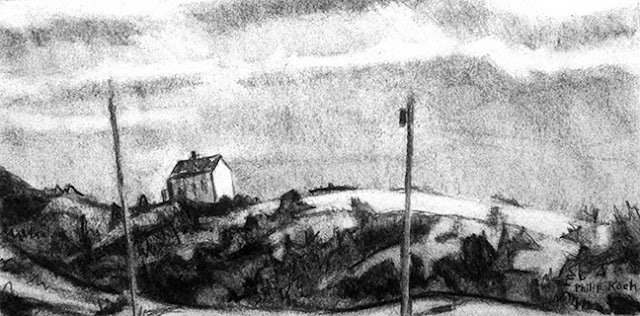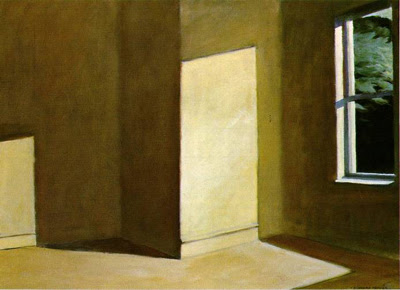Poison Ivy's Enduring Beauty
Late in September we often take a painting trip to Cape Cod, sometimes to stay and work in the Edward Hopper studio in Truro. As we live in the mid-Atlantic area where summer lingers, the trip north is often our first big hit of Fall. Nothing looks as startling as the burning reds you see that time of year on the Cape Cod dunes. Trouble is, it's poison ivy. It's beauty is of a deep oily burnished red. You have to appreciate from afar. Above is a sample of that tricky little plant I took last Fall in Eastham, MA, the town where Edward Hopper painted his gorgeous oil Route 6, Eastham that I discussed in my previous post.
I can think of other kinds of beauty that you can't just run out and embrace. Green plants can stare at the sun all day. If we try it, it can blind us. So instead we look at it obliquely, appreciating it by watching how it shines on objects and casts long shadows. Like sunlight, the same sort of attraction can hit you when you're looking at the work of a truly great artist. It can be a little overwhelming.
For me Edward Hopper is like that. Years ago he was a guide for me, leading me out of a confused swamp of abstract paintings I was doing. I saw the sense of light he could paint and I just had to shoot for similar results. It led to lots of paintings of victorian style houses that I'm extremely proud of. Years passed and I came to feel too confined by imitating Hopper directly. So I made a decision to do paintings whose recipe couldn't be found in the Hopper cookbook. That said, I still find Hopper's paintings seductively beautiful and look at them a lot, just like the rust and ruby foliage of Cape Cod's autumnal poison ivy.
On our way home from the Hopper studio last Fall we stopped in at the Rhode Island School of Design Art Museum. It's a place with a great permanent collection and perhaps the wackiest layout I've ever seen in a museum. Just try not to get lost.
Here's a William Bradford, Arctic Sunset, an oil from 1874 from the RISD Museum. I like it in part because it reminds me of the huge winter ice formations that would form in my neighborhood on the shore of Lake Ontario. As kids we'd play all over them, but one had to be careful not to slip and slide into the freezing waters. My neighbor's dog Gigi did just that and drowned. Afterwards we kids realized our parents' warnings to be careful on the ice weren't just idle talk.
Bradford's painting relies of the giant ice formations for much of its strength. But the artist was sharp enough to design into his composition a contrasting rhythm in the shapes of open water slicing through the foreground ice.
While we're on Cape Cod I paint my brains out and my hard-working wife Alice takes a well deserved break from her job at the mental hospital. At night we do the real tourist thing and go eat in one of Provincetown's restaurants. Our favorite is Napi's. Below is one of the restaurant's resident cats, greeting customers for the dinner hour.
And here's a picture of Alice getting blown away by a blast of wind off Cape Cod Bay. That's Hopper's studio in the background. Old Hopper picked some pretty nice real estate for himself, didn't he.
And here's another painter I love but who I try not to imitate, George Inness. This is In the Berkshire Hills, oil, 1877-78, another painting we saw on our swing through the RISD Museum. Inness had mastered a technique of dry brushing some of his edges- that is, letting tiny dots of paint spill out onto adjoining areas of color. It gives his work almost an instant atmosphere. He could handle this beautifully, but there are some contemporary painters who take this method and go hog wild with it, making paintings that are atmospheric and mechanical looking at the same time.
I love Inness. At his best, and I think this one in the RISD Collection is a good example, he could blend together a sense of massive weight and scale, feathery textures, moving clouds, and poignant sunlight. This is the sort of painting one can study for hours and I recommend that artists do just that. We can learn from Inness without having to be Inness.
Here's a photo Alice took of me on that same painting trip to the Cape. It's in the little town of Wellfleet by the rickety Uncle Tim's Bridge that takes you across an inlet in the harbor. I've just finished painting for the day and we're probably headed to Provincetown to go out to dinner. As you can see, I'm having a terrible time, intensely suffering for my art.








